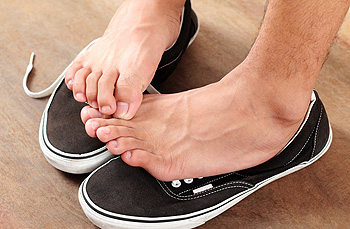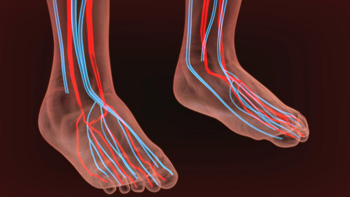 Hyperhidrosis is the medical term for a condition that causes excessive sweating all over the body. Plantar hyperhidrosis is a form of this condition that specifically affects the feet. This ailment usually begins in childhood or adolescence, and in severe cases can cause some physical limitations. The extra moisture can make the feet more prone to bacterial or fungal infections and blisters. Tinea pedis and pitted keratolysis are two examples of possible infections that can result from excess moisture. These two infections can easily be treated with antifungal cream, antibiotic cream, or medication. Plantar hyperhidrosis is symmetric, so it affects both feet equally. The sweating can range from mild excessive sweating to severe constant sweating. If you think you may have plantar hyperhidrosis, then it is recommended you consult with a podiatrist to learn new methods to help living with this condition.
Hyperhidrosis is the medical term for a condition that causes excessive sweating all over the body. Plantar hyperhidrosis is a form of this condition that specifically affects the feet. This ailment usually begins in childhood or adolescence, and in severe cases can cause some physical limitations. The extra moisture can make the feet more prone to bacterial or fungal infections and blisters. Tinea pedis and pitted keratolysis are two examples of possible infections that can result from excess moisture. These two infections can easily be treated with antifungal cream, antibiotic cream, or medication. Plantar hyperhidrosis is symmetric, so it affects both feet equally. The sweating can range from mild excessive sweating to severe constant sweating. If you think you may have plantar hyperhidrosis, then it is recommended you consult with a podiatrist to learn new methods to help living with this condition.
If you are suffering from hyperhidrosis contact one of our podiatrists of San Antonio New Step. Our doctors can provide the care you need to attend to all of your foot and ankle needs.
Hyperhidrosis of the Feet
Hyperhidrosis is a rare disorder that can cause people to have excessive sweating of their feet. This can usually occur all on its own without rigorous activity involved. People who suffer from hyperhidrosis may also experience sweaty palms.
Although it is said that sweating is a healthy process meant to cool down the body temperature and to maintain a proper internal temperature, hyperhidrosis may prove to be a huge hindrance on a person’s everyday life.
Plantar hyperhidrosis is considered to be the main form of hyperhidrosis. Secondary hyperhidrosis can refer to sweating that occurs in areas other than the feet or hands and armpits. Often this may be a sign of it being related to another medical condition such as menopause, hyperthyroidism and even Parkinson’s disease.
In order to alleviate this condition, it is important to see your doctor so that they may prescribe the necessary medications so that you can begin to live a normal life again. If this is left untreated, it is said that it will persist throughout an individual’s life.
A last resort approach would be surgery, but it is best to speak with your doctor to find out what may be the best treatment for you.
If you have any questions please feel free to contact one of our offices located in San Antonio, TX. We offer the newest diagnostic and treatment technologies for all your foot and ankle needs.
Read more about Hyperhidrosis of the Feet It is relatively simple to detect the condition that is known as hammertoe. The middle toes are bent in a downward position, which may often be the result of wearing shoes that are too tight. This type of shoe may not provide adequate room for the toes to move freely in. Additionally, this may create an imbalance in the muscles of the toes and may cause difficulty in straightening the toe. The symptoms that are associated with hammertoe may include pain and discomfort, corns or calluses, or difficulty in walking. Treatment may include using appropriate cushioning on the affected toe or toes, and treating any corns or calluses that may be present. If you feel you have hammertoe, it is advised to consult with a podiatrist who can perform a proper diagnosis, followed by beginning the treatment that is right for you.
It is relatively simple to detect the condition that is known as hammertoe. The middle toes are bent in a downward position, which may often be the result of wearing shoes that are too tight. This type of shoe may not provide adequate room for the toes to move freely in. Additionally, this may create an imbalance in the muscles of the toes and may cause difficulty in straightening the toe. The symptoms that are associated with hammertoe may include pain and discomfort, corns or calluses, or difficulty in walking. Treatment may include using appropriate cushioning on the affected toe or toes, and treating any corns or calluses that may be present. If you feel you have hammertoe, it is advised to consult with a podiatrist who can perform a proper diagnosis, followed by beginning the treatment that is right for you.
Hammertoe
Hammertoes can be a painful condition to live with. For more information, contact one of our podiatrists from San Antonio New Step. Our doctors will answer any of your foot- and ankle-related questions.
Hammertoe is a foot deformity that affects the joints of the second, third, fourth, or fifth toes of your feet. It is a painful foot condition in which these toes curl and arch up, which can often lead to pain when wearing footwear.
Symptoms
Causes
Genetics – People who are genetically predisposed to hammertoe are often more susceptible
Arthritis – Because arthritis affects the joints in your toes, further deformities stemming from arthritis can occur
Trauma – Direct trauma to the toes could potentially lead to hammertoe
Ill-fitting shoes – Undue pressure on the front of the toes from ill-fitting shoes can potentially lead to the development of hammertoe
Treatment
Orthotics – Custom made inserts can be used to help relieve pressure placed on the toes and therefore relieve some of the pain associated with it
Medications – Oral medications such as anti-inflammatories or NSAIDs could be used to treat the pain and inflammation hammertoes causes. Injections of corticosteroids are also sometimes used
Surgery – In more severe cases where the hammertoes have become more rigid, foot surgery is a potential option
If you have any questions please contact one of our offices located in San Antonio, TX. We offer the newest diagnostic and treatment technologies for all your foot and ankle needs.
Read more about What Are Hammertoes? Many people stand for the majority of the day while working.Foot pain may develop gradually or suddenly, and may often be a result of working on your feet for extended periods of time. There may be moderate relief that can be attained by wearing shoe inserts or standing on stress mats instead of concrete floors. Additionally, it may be beneficial to walk occasionally throughout the day, and this may help the feet to stretch. It’s important that correct shoes are worn, which generally includes making sure the shoes have a good arch and adequate support. Many patients find it is helpful to rest the feet during the day when possible. If you are experiencing any type of foot pain that may be a result of working on your feet, it is suggested to speak with a podiatrist who can properly assist you.
Many people stand for the majority of the day while working.Foot pain may develop gradually or suddenly, and may often be a result of working on your feet for extended periods of time. There may be moderate relief that can be attained by wearing shoe inserts or standing on stress mats instead of concrete floors. Additionally, it may be beneficial to walk occasionally throughout the day, and this may help the feet to stretch. It’s important that correct shoes are worn, which generally includes making sure the shoes have a good arch and adequate support. Many patients find it is helpful to rest the feet during the day when possible. If you are experiencing any type of foot pain that may be a result of working on your feet, it is suggested to speak with a podiatrist who can properly assist you.
While working on the feet, it is important to take the proper care of them. For more information about working on your feet, contact one of our podiatrists from San Antonio New Step. Our doctors will treat your foot and ankle needs.
Working on Your Feet
Standing on your feet for long periods of time can cause stress and pain in your feet. Your whole body may experience change in terms of posture, back pain, bunions, callouses and or plantar warts. There are ways to avoid these conditions with proper foot care, smart choices and correct posture.
Positive Changes
Negative heeled shoe – Choosing this shoe type places the heel slightly lower than the ball of the foot. These are great for overall foot health. Find shoes that fit you correctly.
Go barefoot – Our feet were not designed to be enclosed for all hours of the day. Try to periodically expose your feet to air.
Eliminate Pain
Foot Exercises – Performing simple exercises, incorporating yoga and doing stretches are beneficial. This will allow increased blood flow to the area and muscles of the foot.
Achilles tendon – Stretching the foot out flat on the floor will relax the calf muscles and tendon. These exercises can be performed almost anywhere. Make sure you add these exercises to your daily regimen.
With a little bit of this information and knowing more about foot health, you will notice changes. Foot stretches and proper footwear will help with pain and prevent further issues.
If you have any questions please feel free to contact one of our offices located in San Antonio, TX. We offer the newest diagnostic and treatment technologies for all your foot and ankle needs.
Read more about Working on Your Feet The symptoms which are often experienced if you have poor circulation may be a tingling sensation in the hands and feet, in addition to feeling cold frequently throughout the day. Research has indicated it may be a symptom of a serious health issue which may include a heart attack or stroke. Poor circulation may develop as a result of a compromised blood flow, and this may prevent the body’s organs from receiving nutrients and oxygen. Some patients may notice muscle cramps in their feet, a general feeling of fatigue, or possibly pain and discomfort in the affected limbs. There may be measures that can be implemented which may help the symptoms of this condition, and these may include incorporating a gentle exercise program into your daily routine, and ingesting foods which can lead to a healthy lifestyle. If you are noticing any symptoms of poor circulation, it is advised to seek a consultation with a podiatrist who can properly diagnosis this condition.
The symptoms which are often experienced if you have poor circulation may be a tingling sensation in the hands and feet, in addition to feeling cold frequently throughout the day. Research has indicated it may be a symptom of a serious health issue which may include a heart attack or stroke. Poor circulation may develop as a result of a compromised blood flow, and this may prevent the body’s organs from receiving nutrients and oxygen. Some patients may notice muscle cramps in their feet, a general feeling of fatigue, or possibly pain and discomfort in the affected limbs. There may be measures that can be implemented which may help the symptoms of this condition, and these may include incorporating a gentle exercise program into your daily routine, and ingesting foods which can lead to a healthy lifestyle. If you are noticing any symptoms of poor circulation, it is advised to seek a consultation with a podiatrist who can properly diagnosis this condition.
Poor circulation is a serious condition and needs immediate medical attention. If you have any concerns with poor circulation in your feet contact one of our podiatrists of San Antonio New Step. Our doctors will treat your foot and ankle needs.
Poor Circulation in the Feet
Poor blood circulation in the feet and legs is can be caused by peripheral artery disease (PAD), which is the result of a buildup of plaque in the arteries.
Plaque buildup or atherosclerosis results from excess calcium and cholesterol in the bloodstream. This can restrict the amount of blood which can flow through the arteries. Poor blood circulation in the feet and legs are sometimes caused by inflammation in the blood vessels, known as vasculitis.
Causes
Lack of oxygen and oxygen from poor blood circulation restricts muscle growth and development. It can also cause:
Those who have diabetes or smoke are at greatest risk for poor circulation, as are those who are over 50. If you have poor circulation in the feet and legs it may be caused by PAD and is important to make changes to your lifestyle in order to reduce risk of getting a heart attack or stroke. Exercise and maintaining a healthy lifestyle will dramatically improve conditions.
As always, see a podiatrist as he or she will assist in finding a regimen that suits you. A podiatrist can also prescribe you any needed medication.
If you have any questions please feel free to contact one of our offices located in San Antonio, TX. We offer the newest diagnostic and treatment technologies for all your foot and ankle needs.
Read more about Causes, Symptoms, and Treatment of Poor Blood Circulation in the Feet